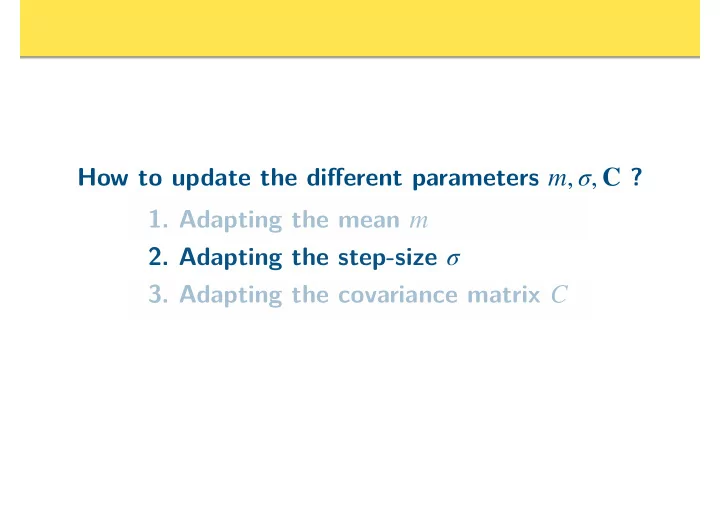

How to update the di ff erent parameters m , σ , C ? 1. Adapting the mean m 2. Adapting the step-size σ 3. Adapting the covariance matrix C
Why Step-size Adaptation? Assume a (1+1)-ES algorithm with fi xed step-size (and σ n ∑ x 2 i = ∥ x ∥ 2 ) optimizing the function . C = I d f ( x ) = i =1 Initialize m , σ While (stopping criterion not met) sample new solution: What will happen if you x ← m + σ 𝒪 (0, I d ) look at the convergence if f ( x ) ≤ f ( m ) of f ( m )? m ← x
Why Step-size Adaptation? red curve: (1+1)-ES with optimal step-size (see later) σ = 10 − 3 green curve: (1+1)-ES with constant step-size ( )
Why Step-size Adaptation? We need step-size adaptation to approach the optimum fast (converge linearly) red curve: (1+1)-ES with optimal step-size (see later) σ = 10 − 3 green curve: (1+1)-ES with constant step-size ( )
Methods for Step-size Adaptation 1/5th success rule, typically applied with “+” selection [Rechenberg, 73][Schumer and Steiglitz, 78][Devroye, 72] [Schwefel, 81] -self adaptation, applied with “,” selection σ random variation is applied to the step-size and the better one, according to the objective function value, is selected path-length control or Cumulative step-size adaptation (CSA), applied with “,” selection [Ostermeier et al. 84][Hansen, Ostermeier, 2001] two-point adaptation (TPA), applied with “,” selection [Hansen 2008] test two solutions in the direction of the mean shift, increase or decrease accordingly the step-size
Step-size control: 1/5th Success Rule
Step-size control: 1/5th Success Rule
Step-size control: 1/5th Success Rule probability of success per iteration: ps = #candidate solutions better than m #candidate solutions [ f ( x ) ≤ f ( m )]
(1+1)-ES with One- fi fth Success Rule - Convergence
Path Length Control - Cumulative Step-size Adaptation (CSA) step-size adaptation used in the -ES algorithm framework (in ( μ / μ w , λ ) CMA-ES in particular) Main Idea:
CSA-ES The Equations
Convergence of -CSA-ES ( μ / μ w , λ ) 2x11 runs
Convergence of -CSA-ES ( μ / μ w , λ ) σ 0 = 10 − 2 Note: initial step-size taken too small ( ) to illustrate the step-size adaptation
Convergence of -CSA-ES ( μ / μ w , λ )
Optimal Step-size - Lower-bound for Convergence Rates In the previous slides we have displayed some runs with “optimal” step-size. Optimal step-size relates to step-size proportional to the distance to σ t = σ ∥ x − x ⋆ ∥ x ⋆ the optimum: where is the optimum of the optimized function (with properly chosen). σ The associated algorithm is not a real algorithm (as it needs to know the distance to the optimum) but it gives bounds on convergence rates and allows to compute many important quantities. The goal for a step-size adaptive algorithm is to achieve convergence rates close to the one with optimal step-size
We will formalize this in the context of the (1+1)-ES. Similar results can be obtained for other algorithm frameworks.
Optimal Step-size - Bound on Convergence Rate - (1+1)-ES Consider a (1+1)-ES algorithm with any step-size adaptation mechanism: X t +1 = { X t + σ t 𝒪 t +1 if f ( X t + σ t 𝒪 t +1 ) ≤ f ( X t ) X t otherwise with i.i.d. { 𝒪 t , t ≥ 1} ∼ 𝒪 (0, I d ) equivalent writing: X t +1 = X t + σ t 𝒪 t +1 1 { f ( X t + σ t 𝒪 t +1 ) ≤ f ( X t )}
Bound on Convergence Rate - (1+1)-ES f : ℝ n → ℝ Theorem: For any objective function , for any y ⋆ ∈ ℝ n E [ ∥ X t +1 − y ⋆ ∥ ] ≥ E [ ∥ X t − y ⋆ ∥ ] − τ lower bound σ ∈ℝ > E [ln − ∥ e 1 + σ 𝒪∥ ] where with τ = max e 1 = (1,0,…,0) =: φ ( σ ) Theorem: The convergence rate lower-bound is reached on f ( x ) = g ( ∥ x − x ⋆ ∥ ) spherical functions (with strictly g : ℝ ≥ 0 → ℝ increasing) and step-size proportional to the distance to the σ t = σ opt ∥ x − x ⋆ ∥ optimum with such that . σ opt φ ( σ opt ) = τ
Log-Linear Convergence of scale-invariance step-size ES Theorem: The (1+1)-ES with step-size proportional to the distance to the optimum converges (log)-linearly σ t = σ ∥ x ∥ on the sphere function almost surely: f ( x ) = g ( ∥ x ∥ ) t ln ∥ X t ∥ 1 ∥ X 0 ∥ t →∞ − φ ( σ ) =: CR (1+1) ( σ )
Asymptotic Results ( n → ∞ )
Recommend
More recommend